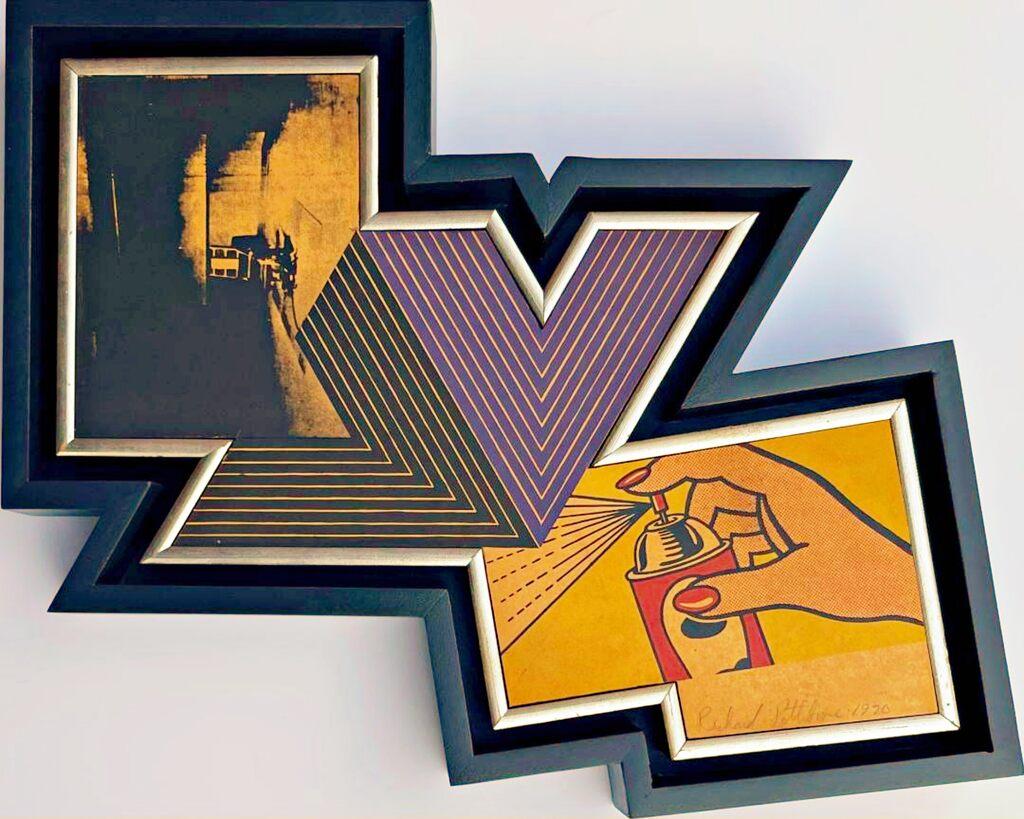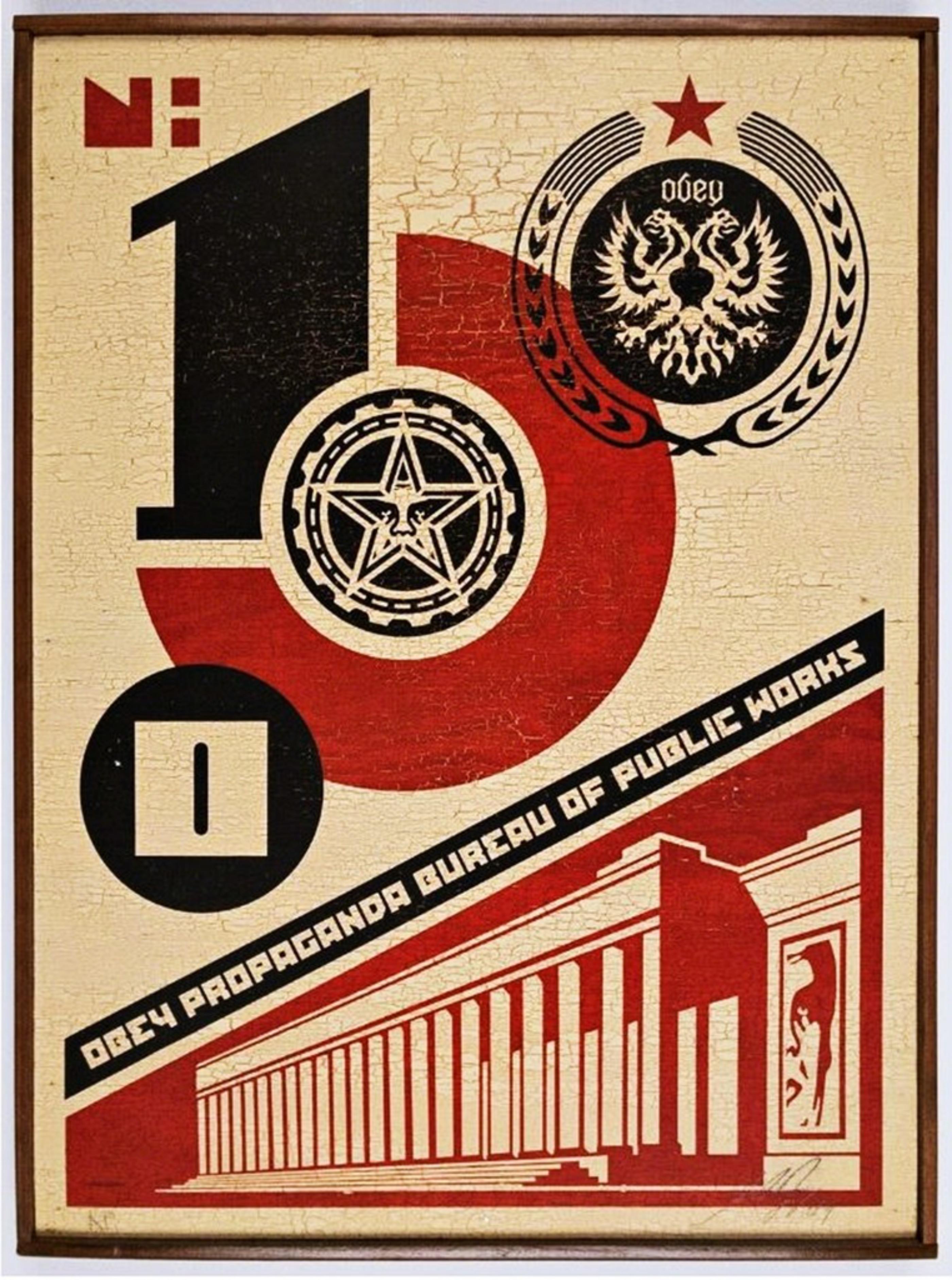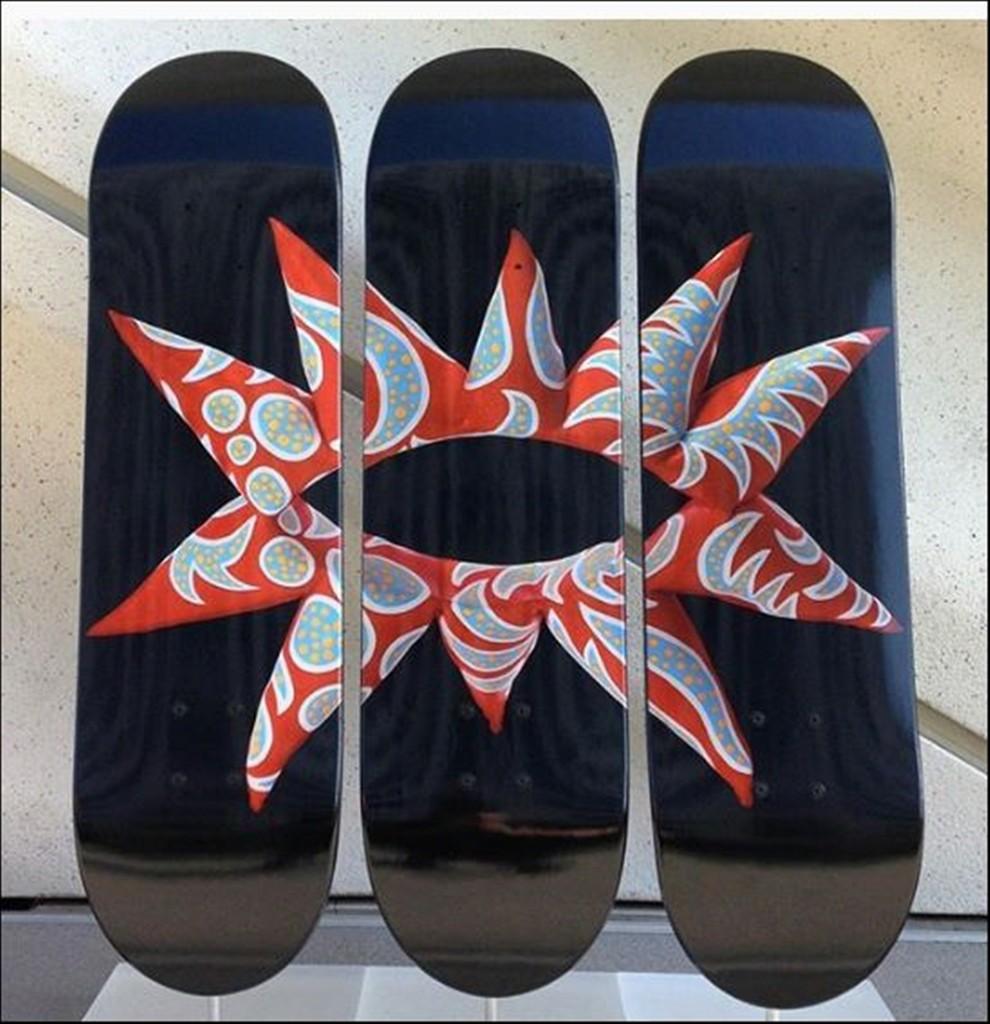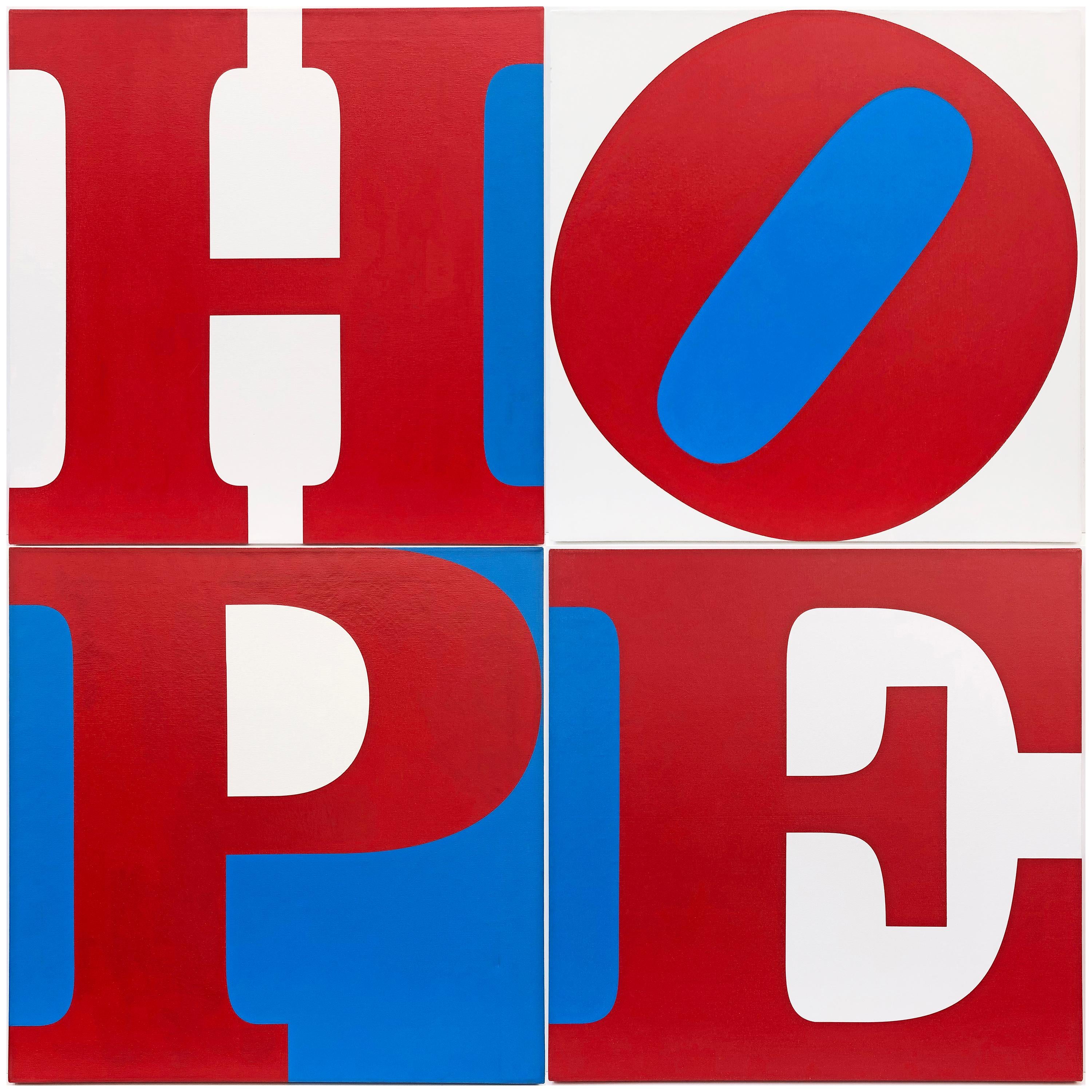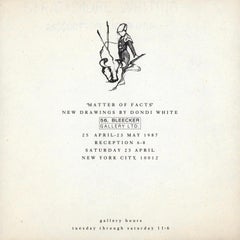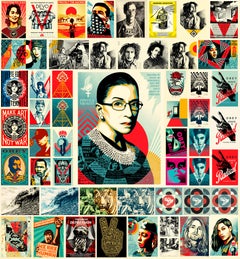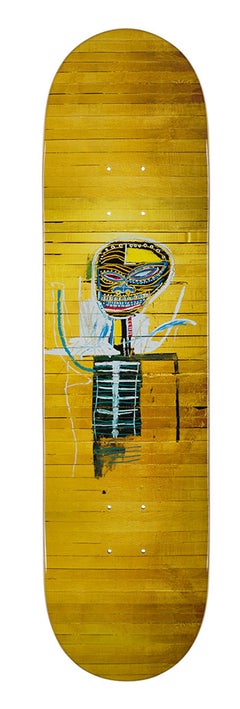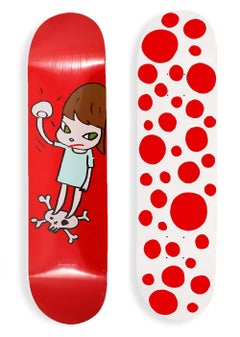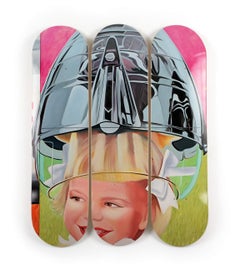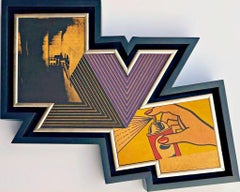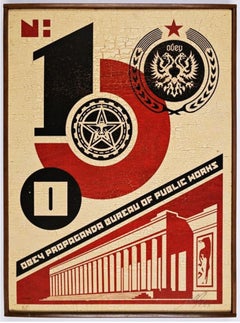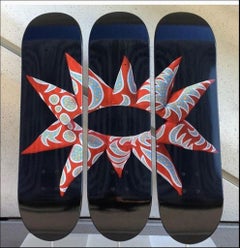Items Similar to Keith Haring crawling baby Skateboard Deck (Keith Haring skate deck)
Want more images or videos?
Request additional images or videos from the seller
1 of 8
(after) Keith HaringKeith Haring crawling baby Skateboard Deck (Keith Haring skate deck)c.2013
c.2013
About the Item
Vintage Keith Haring Skateboard Deck featuring the artist's most recognized & iconic image, the Crawling Baby. This work originated circa 2013 as a result of the collaboration between Alien Workshop skateboards and the Keith Haring Foundation.
With the estate licensed Haring printed signature on the reverse. Makes for unique, vibrant wall-art that hangs with ease. This work is out of print and will not be reproduced.
Medium: Silkscreen on maple wood skate deck.
Approximate Dimensions: 8 x 31 inches.
Condition: Good overall vintage condition. Minor storage wear & markings to front and reverse. Far edge of deck contains wear not effecting or visible to artwork.
Keith Haring (b.1958 Reading, PA):
From a young age he enjoyed drawing, especially Disney characters and other cartoons. He initially wanted to become a commercial artist but after a year at the Ivy School of Professional Art in Pittsburgh, Haring dropped, moved to New York City and enrolled in the School of Visual Arts (SVA). Haring immediately felt connected to the thriving alternative arts scene happening downtown in the late 1970s and became friends with Jean-Michel Basquiat and Kenny Scharf.
Haring’s first major works were his subway drawings. Haring produced a large number of these public works between 1980 and 1985, integrating his motifs outlined figures into everyday public space in a way that directly engaged its viewers.
Haring's 1st solo exhibition was held at Westbeth Painters Space in 1981 and a celebrated show debuted at the historic Tony Shafrazi Gallery in New York the following year.
Throughout the 1980s, Haring was committed to democratizing the art experience and along with paintings, he also created theater sets, billboards, murals, advertising campaigns and even a line of Swatch watches. In 1986 he opened the Pop Shop in SoHo, selling apparel, posters and toys bearing his drawings. This was a controversial move, as many galleries criticized Haring for “de-valuing” the art object while others, such as Andy Warhol, championed Haring’s insistence on making art accessible and affordable. Pop Shop was highly influential to contemporary crossovers of art and merchandise that are now so dominant, as in the work of Jeff Koons, Yayoi Kusama, KAWS and Takashi Murakami.
In addition to this ideology of accessibility, Haring was also very socially engaged and used his striking imagery to promote awareness of various political and social campaigns. His many notable public works included a mural on the western side of the Berlin Wall, the Crack is Wack mural in New York, and a mural for the 100th anniversary of the Statue of Liberty in 1986. Haring was diagnosed with AIDS in 1988 and used his presence in the arts community to raise awareness of the crisis. In 1989, a year before his death, he established the Keith Haring Foundation, whose mission is to raise funds for AIDS organizations and children’s literacy and arts programs.
Since his death in 1990, Haring has become one of the most widely-recognized and celebrated artists of the 20th century.
Related categories:
Keith Haring skate deck. Keith Haring skateboard deck. Skate art. Basquiat. Andy Warhol. Pop Art. Graffiti. Street art. Keith Haring Crawling Baby.
- Creator:(after) Keith Haring (1958 - 1990, American)
- Creation Year:c.2013
- Dimensions:Height: 31 in (78.74 cm)Width: 8 in (20.32 cm)
- Medium:
- Movement & Style:
- Period:
- Condition:
- Gallery Location:NEW YORK, NY
- Reference Number:1stDibs: LU354314814332
(after) Keith Haring
Keith Allen Haring was an American artist whose pop art emerged from the New York City graffiti subculture of the 1980s.
About the Seller
5.0
Vetted Professional Seller
Every seller passes strict standards for authenticity and reliability
Established in 2014
1stDibs seller since 2016
4,485 sales on 1stDibs
Typical response time: <1 hour
- ShippingRetrieving quote...Shipping from: NEW YORK, NY
- Return Policy
Authenticity Guarantee
In the unlikely event there’s an issue with an item’s authenticity, contact us within 1 year for a full refund. DetailsMoney-Back Guarantee
If your item is not as described, is damaged in transit, or does not arrive, contact us within 7 days for a full refund. Details24-Hour Cancellation
You have a 24-hour grace period in which to reconsider your purchase, with no questions asked.Vetted Professional Sellers
Our world-class sellers must adhere to strict standards for service and quality, maintaining the integrity of our listings.Price-Match Guarantee
If you find that a seller listed the same item for a lower price elsewhere, we’ll match it.Trusted Global Delivery
Our best-in-class carrier network provides specialized shipping options worldwide, including custom delivery.More From This Seller
View AllDondi White NYC 1987 (Dondi graffiti artist)
Located in NEW YORK, NY
Dondi White NYC 1987:
A rare, highly collectible Dondi White illustrated exhibition announcement published on the occasion of: 'Matter of Facts, New Drawings by Dondi White'. 56 Blee...
Category
1980s Pop Art Abstract Prints
Materials
Lithograph, Screen
Shepard Fairey Screen-prints: collection of 60 works (2009-2022)
By Shepard Fairey
Located in NEW YORK, NY
Shepard Fairey Screen-prints: collection of 60 works: 2009-2022:
A rare assemblage of 60 hand-signed Shepard Fairey screen-prints; collected over a near 15 year period (2009-2022). Notable imagery includes: Bob Marley, Keith Haring, Ruth Bader Ginsburg, Kurt Cobain, as well as a series of vivid anti-war pieces defining the artist's practice (title list found further below). Each very well-preserved.
Medium: Screen-prints on heavy paper. 2009-2022 (see below for a list of titles & years).
Dimensions ranging from: 19.5 x 16 inches to 24x36 inches.
Each work is hand-signed; works are either numbered from their respective main editions or notated 'AP' (see last listing image); a few or several works are signed, but not numbered.
Excellent overall condition with the exception of perhaps some minor signs of handling on a few examples.
Provenance: Private collection New York via Shepard Fairey.
Listing images beginning with image 2 represent the actual works.
These works will be shipped flat using protective materials. Please feel free to contact us with any additional questions.
Titles & Years:
OCEAN TODAY...
Category
2010s Pop Art Abstract Prints
Materials
Lithograph, Screen
Basquiat Gold Griot Skateboard Deck (Basquiat skate deck)
By (after) Jean-Michel Basquiat
Located in NEW YORK, NY
Basquiat Gold Griot Skateboard Deck c. 2019:
Maple wood. Dimensions: 31 x 8 inches.
Housed in original shrink wrapping. Excellent overall condition.
Published from a limited seri...
Category
21st Century and Contemporary Pop Art Abstract Prints
Materials
Wood, Offset
Yayoi Kusama Yoshitomo Nara Skateboard decks (MoMa)
By Yoshitomo Nara
Located in NEW YORK, NY
Yayoi Kusama & Yoshitomo Nara MoMa Skateboard Decks (2 works):
A set of 2 MoMa published skateboard decks featuring Kusama's Dots Obsession imagery & Nara’s ‘Solid Fist’ girl.
Make...
Category
21st Century and Contemporary Pop Art Abstract Sculptures
Materials
Wood, Lithograph, Offset
Yayoi Kusama Skateboard deck (Yayoi Kusama MoMa)
By Yayoi Kusama
Located in NEW YORK, NY
Yayoi Kusama Skateboard Deck:
This Kusama skateboard deck features Kusama's Dots Obsession imagery and makes for standout Kusama wall art that ...
Category
1960s Pop Art Abstract Sculptures
Materials
Wood, Lithograph, Offset
Keith Haring Fun Gallery 1983 (announcements set of 2)
By Keith Haring
Located in NEW YORK, NY
Keith Haring Fun Gallery 1983:
A set of 2 rare original 1983 Keith Haring illustrated announcements published on the occasion of Haring's historic ...
Category
1980s Pop Art Prints and Multiples
Materials
Offset
You May Also Like
James Rosenquist F-111 TRIPTYCH (GIRL) Limited Skate Modern Design Pop American
By James Rosenquist
Located in Madrid, Madrid
James Rosenquist F-111 TRIPTYCH A (GIRL)
Date of creation: 2021
Medium: Digital print on Canadian maple wood
Edition: 100
Size: 80 x 20 cm (each skate)
Condition: In mint conditions ...
Category
2010s Pop Art Abstract Prints
Materials
Wood, Maple, Screen
Richard Pettibone The Appropriation Warhol, Stella, Lichtenstein, Unique Signed
By Richard Pettibone
Located in New York, NY
Richard Pettibone
The Appropriation Print Andy Warhol, Frank Stella, Roy Lichtenstein, 1970
Silkscreen in colors on masonite board (unique variant on sculpted board)
Hand-signed by artist, Signed and dated on the front (see close up image)
Bespoke frame Included
This example of Pettibone's iconic Appropriation Print is silkscreened on masonite board rather than paper, giving it a different background hue, and enabling it work to be framed so uniquely.
The Appropriation print is one of the most coveted prints Pettibone ever created ; the regular edition is on a full sheet with white background; the present example was silkscreened on board, allowing it to be framed in 3-D. While we do not know how many examples of this graphic work Pettibone created, so far the present work is the only one example we have ever seen on the public market since 1970. (Other editions of The Appropriation Print have been printed on vellum, wove paper and pink and yellow paper.)
This 1970 homage to Andy Warhol, Frank Stella and Roy Lichtenstein exemplifies the type of artistic appropriation he was engaging in early on during the height of the Pop Art movement - long before more contemporary artists like Deborah Kass, Louise Lawler, etc. followed suit.
This silkscreen was in its original 1970 vintage period frame; a bespoke custom hand cut black wood outer frame was subsequently created especially to house the work, giving it a distinctive sculptural aesthetic.
Measurements:
Framed 14.5 inches vertical by 18 inches horizontal by 2 inches
Work
13 inches vertical by 16.5 inches horizontal
Richard Pettibone biography:
Richard Pettibone (American, b.1938) is one of the pioneering artists to use appropriation techniques. Pettibone was born in Los Angeles, and first worked with shadow boxes and assemblages, illustrating his interest in craft, construction, and working in miniature scales. In 1964, he created the first of his appropriated pieces, two tiny painted “replicas” of the iconic Campbell’s soup cans by Andy Warhol (American, 1928–1987). By 1965, he had created several “replicas” of paintings by American artists, such as Warhol, Roy Lichtenstein (1923–1997), Ed Ruscha (b.1937), and others, among them some of the biggest names in Pop Art. Pettibone chose to recreate the work of leading avant-garde artists whose careers were often centered on themes of replication themselves, further lending irony to his work. Pettibone also created both miniature and life-sized sculptural works, including an exact copy of Bicycle Wheel by Marcel Duchamp (French, 1887–1968), and in the 1980s, an entire series of sculptures of varying sizes replicating the most famous works of Constantin Brancusi (Romanian, 1876–1957). In more recent years, Pettibone has created paintings based on the covers of poetry books by Ezra Pound, as well as sculptures drawn from the grid compositions of Piet Mondrian (Dutch, 1872–1944). Pettibone straddles the lines of appropriation, Pop, and Conceptual Art, and has received critical attention for decades for the important questions his work raises about authorship, craftsmanship, and the original in art. His work has been exhibited at the Institute for Contemporary Art in Philadelphia, the Museum of Modern Art in New York, the Museum of Contemporary Art in Miami, and the Laguna Art Museum in Laguna Beach, CA. Pettibone is currently based in New York.
"I wished I had stuck with the idea of just painting the same
painting like the soup can and never painting another painting.
When someone wanted one, you would just do another one.
Does anybody do that now?"
Andy Warhol, 1981
Since the mid-1960s, Richard Pettibone has been making
hand-painted, small-scale copies of works by other artists — a
practice due to which he is best known as a precursor of appropriation art — and for a decade now, he has been revisiting subjects from across his career. In his latest exhibitions at
Castelli Gallery, Pettibone has been showing more of the “same”
paintings that had already been part of his 2005–6 museum retrospective,1
and also including “new” subject matter drawn from
his usual roster of European modernists and American postwar
artists. Art critic Kim Levin laid out some phases of the intricate spectrum from copies to repetitions in her review of the
Warhol-de Chirico showdown, a joint exhibition at the heyday
of appropriation art in the mid-1980s when Warhol’s appropriations of de Chirico’s work effectively revaluated “the grand
old auto-appropriator”.
Upon having counted well over a dozen
Disquieting Muses by de Chirico, Levin speculated: “Maybe he
kept doing them because no one got the point. Maybe he needed the money. Maybe he meant it when he said his technique
had improved, and traditional skills were what mattered.”
On
the other side, Warhol, in her eyes, was the “latter-day exemplar
of museless creativity”.
To Pettibone, traditional skills certainly
still matter, as he practices his contemporary version of museless creativity. He paints the same painting again and again,
no matter whether anybody shows an interest in it or not. His
work, of course, takes place well outside the historical framework of what Levin aptly referred to as the “modern/postmodern wrestling match”,
but neither was this exactly his match
to begin with.
Pettibone is one of appropriation art’s trailblazers, but his diverse
selection of sources removes from his work the critique of the
modernist myth of originality most commonly associated with
appropriation art in a narrow sense, as we see, for example, in
Sherrie Levine’s practice of re-photographing the work of Walker
Evans and Edward Weston. In particular, during his photorealist
phase of the 1970s, Pettibone’s sources ranged widely across
several art-historical periods. His appropriations of the 1980s
and 1990s spanned from Picasso etchings and Brancusi sculptures to Shaker furniture and even included Ezra Pound’s poetry.
Pettibone has professed outright admiration for his source artists, whose work he shrinks and tweaks to comic effect but, nevertheless, always treats with reverence and care. His response
to these artists is primarily on an aesthetic level, owing much
to the fact that his process relies on photographs. By the same
token, the aesthetic that attracts him is a graphic one that lends
itself to reproduction. Painstakingly copying other artists’ work by hand has been a way of making
it his own, yet each source is acknowledged in
his titles and, occasionally, in captions on white
margins that he leaves around the image as an
indication that the actual source is a photographic image. The enjoyment he receives in copying
is part of the motivation behind doing it, as is
the pleasure he receives from actually being with
the finished painting — a considerable private
dimension of his work. His copies are “handmade
readymades” that he meticulously paints in great quantities in his studio upstate in New York; the commitment
to manual labor and the time spent at material production has
become an increasingly important dimension of his recent work.
Pettibone operates at some remove from the contemporary art
scene, not only by staying put geographically, but also by refusing to recoup the simulated lack of originality through the
creation of a public persona.
In so doing, Pettibone takes a real
risk. He places himself in opposition to conceptualism, and he is
apprehensive of an understanding of art as the mere illustration
of an idea. His reading of Marcel Duchamp’s works as beautiful
is revealing about Pettibone’s priorities in this respect.
When
Pettibone, for aesthetic pleasure, paints Duchamp’s Poster for
the Third French Chess...
Category
1970s Pop Art Abstract Prints
Materials
Masonite, Pencil, Screen
Shepard Fairey, Bureau of Public Works Twice Signed work on wood panel AP
By Shepard Fairey
Located in New York, NY
SHEPARD FAIREY
Bureau of Public Works (on Wood), 2004
Silkscreen on wood panel. Hand signed and annotated on both the recto and verso. In original handmade artist's frame.
24 × 18 in...
Category
Early 2000s Pop Art Abstract Prints
Materials
Wood, Screen
With all My Flowering Heart Skateboard Triptych, 3 Limited Edition Skate Decks
By Yayoi Kusama
Located in New York, NY
Yayoi Kusama
With All My Flowering Heart (Triptych), 2014
Set of Three (3) Separate Limited Edition numbered skate decks on 7-ply Canadian maple wood
31 × 8 × 2/5 inches (each)
Hand ...
Category
2010s Pop Art Abstract Prints
Materials
Wood, Mixed Media, Permanent Marker, Screen
Deceleration I, 1968 - Graphic Pop Art Screenprint, White, Blue and Red, 20th C
By Gerald Laing
Located in Kingsclere, GB
Laing was born in Newcastle upon Tyne. He grew up during World War II and experienced the Battle of Britain as young boy.
He attended the Royal Military Academy Sandhurst and served...
Category
1960s Pop Art Prints and Multiples
Materials
Screen
HOPE (R/W/B), large original 4 panel painting
By Robert Indiana
Located in Aventura, FL
Acrylic and silkscreen ink on triple primed canvas. Hand signed, dated, titled and numbered "P/P" on verso by Robert Indiana. Printer's Proof edition.
Total of 4 panels. Each pan...
Category
Early 2000s Pop Art Abstract Prints
Materials
Canvas, Screen, Acrylic
$760,000 Sale Price
20% Off

